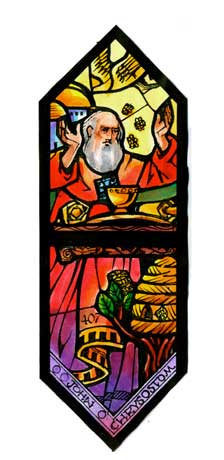|
|
|||

|
|||
John Chrysostom Window Persecution of Christians continued sporadically until the fourth century, when it was ended by the Emperor Constantine. The favor shown to Christianity ushered in the era of the Imperial Church. Some saw the hand of God in the newfound security and comfort; others saw it as the greatest enemy of the church, and wrestled with how to be true Christians under such circumstances. The latter became some of the first solitaries and monastics, leaving behind the safety of the civilized world to face their inner demons in the desert. John Chrysostom (born c. 354) was one of those monks, living for a time in the Syrian mountains, until his health broke and he returned to Antioch. There he served as a priest, becoming a popular and gifted orator and liturgist. John revered the liturgy, describing it as a glorious experience, in which people “join with the Cherubim themselves, and the heavenly powers, in offering up sacred hymns.” He became so sought after that he was kidnapped and brought to Constantinople, the eastern capital of the Empire, and consecrated bishop in 398. As Patriarch, John condemned the lavish lifestyles and lax moral standards of the rich, while opening his heart to the poor and oppressed. For this stance, the Emperor exiled John to Armenia, and then still further, to the Caucasus. However, John was aging, and the journey was too harsh. He asked to stop at a chapel along the way. There he preached his last sermon: “In all things, glory to God. Amen.” Then he died. Three years later, Rome would fall, but the Imperial Church of the Byzantine Empire would last another thousand years. John Chrysostom’s window represents the Eastern (Orthodox) branch of Christianity. The buildings in the background recall Constantinople. The bees and hives represent both John’s eloquent oratory and the name Chrysostom, which means golden-mouthed or honey-tongued. He is shown celebrating the Eucharist because he was a writer of liturgies. The dove represents the Holy Spirit’s inspiration, raising our hearts to God through the service. Christ is shown through his mystical presence in the Eucharist. Through the figures of Ignatius of Antioch and John Chrysostom, the New Testament Story of Christ is connected to the continuing Story of the Church.
Like Stars Appearing: The Story of the Stained Glass
Windows of St. George's Episcopal Church, Dayton, Ohio | |||
|
|||
